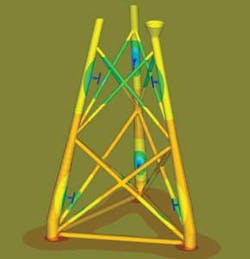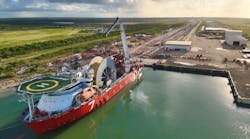James Horton
Frazer-Nash
The task faced by the oil and gas industry to renew some decades-old platforms seems formidable. However, the retrofit of a manageable and cost-effective cathodic protection system is readily achieved when done properly.
With the original cathodic protection systems of many fixed and floating oil and gas platforms in the North Sea reaching the end of their designed lives, retrofit corrosion protection systems will need to be installed over the next few years to allow operators to safely extend the platforms' lives. The importance of designing for reliability, integrity and maintenance is clear, and corrosion protection is an essential part of the solution.
Originally, sacrificial anodes were widely used on oil and gas structures. Some of these are coming to the end of their operational lives and now is the time to consider a replacement system. Engineering analysis has evolved over recent years and now offers opportunities to reduce the cost of protecting vessels and offshore structures from corrosion, which in turn helps profitability.
Cathodic protection systems provide protection against corrosion of offshore structures. Depending on the application, either active or passive systems can be used. Active impressed current cathodic protection (ICCP) systems require anodes to be placed strategically on the structure and to be connected to a power supply and control system, which outputs current to suppress the local corrosive galvanic cells.
The major advantage of ICCP systems over passive sacrificial anodes is that the higher-driving voltage allows for use of fewer anodes that are more widely spaced, reducing installation costs. This does have drawbacks, however. The system is more sensitive to local environmental conditions and more susceptible to over- and under-protection. Its effectiveness also depends on what needs to be protected, whether it is the jacket structures, vessels, subsea manifolds, or pipelines. Each part provides its own challenges and requires specific CP design.
Advantages of ICCP
Seawater, with its high conductivity, is a perfect medium for galvanic corrosion - but it is also an ever-changing environment. Consider a vessel which also moves through different environments from dock to deepwater, and it becomes apparent that careful planning and engineering must be done at the beginning to ensure an ICCP system works efficiently and provides complete protection.
The primary function of ICCP is to prevent corrosion of structures such as jackets, subsea manifolds, and pipelines that spend their life in harsh offshore conditions. This leads to savings, as structures remain protected and reach their designed life span. Safely extending the lives of offshore structures to allow continued production is a current focus in the North Sea. Many existing sacrificial anode systems are nearly consumed, and replacement systems are needed.
The costs incurred to install and maintain offshore structures are significant. These costs can run into millions of dollars to hire specialist vessels and trained crews, and can far exceed the development and upfront costs of an effective corrosion protection system.
ICCP systems, while more expensive than the sacrificial alternative, have fewer components. When installation costs are included, ICCP can become a cheaper alternative to replacing like for like. The lower mass in an ICCP system also places less stress on aging and corroded structures.
Forward planning is essential
A detailed understanding of the area of ocean where a structure will sit is essential. To prepare for the changes that will take place in that environment over the lifetime of a structure, careful modeling and verification must take place. Understanding the complexities of a subsea environment and the intricacies of corrosion mechanisms enables facilities to be better protected because informed decisions can be made and forward planning can ensure the systems work effectively to protect the structures enough, but not too much.
The corrosion protection system must be flexible and able to provide changing outputs to match changing environmental conditions. While it is important that the structure is fully protected, there is the danger with ICCP systems that the structure around anodes can be overprotected, leading to hydrogen embrittlement and coating disbondment.
The main factors affecting seawater conductivity are temperature and salinity, and these change on a seasonal basis. The performance of corrosion protection systems is highly non-linear, so it is not simple to predict accurately performance changes over the seasons. The conditions must be modeled to correctly gauge the changes due to environmental factors and to determine how the system should be configured to generate the required protection levels.
ICCP systems include a feedback loop to measure the protection levels at certain points across the structure. This indicates any changes to output that need to be made to accommodate any seasonal variations. However, just because an ICCP system indicates the structure is protected at a few points, that is not sufficient to assume the structure is completely protected. So, even with feedback, it is probable that as the environmental conditions change the distribution of protection across the structure will change, too.
Detailed modeling is used to develop CP system designs to verify that they provide complete protection in all conditions through the changing seasons and to predict how the required current output changes over the year. This has shown that some layouts are very sensitive to environmental conditions and are not suitable for providing compete protection year round.
If the changes in condition go undetected, the structure can be exposed to both over- and under-protection. This leads to corrosion that reduces structural integrity and damages coatings, exposing more metal to sea water and exacerbating corrosion. The result is increased maintenance, reduced structure life, and potentially large financial losses. It is therefore extremely important to understand the environment around your structure and plan to protect it accordingly.
Over and under
In addition to the environmental changes, there are also physical differences that must be considered. For example, it is not enough to say that a certain amount of ICCP current will be sufficient for all pipelines. Some pipelines may be laid under the seabed, others on top of the seabed with debris holding them in place, while others may be fixed in place with steel structures. Therefore, not only must the environmental factors be considered; it is imperative to understand the implications of how the pipeline is laid.
Oil and gas structures are complex, with different metals coming in contact at various points, such as where valves are positioned and interactions with mooring chains. There is also the exposure to air in the splash zone. Modeling and verification can consider each of these points to ensure the correct level of protection is available at all times.
An overall protector
ICCP works with other corrosion protection systems to ensure good levels of protection. Anti-corrosion coatings, for example, have improved in recent years; some very good options are available that are impermeable and isolate the steel structure from the seawater. Anti-corrosion coatings, however, are susceptible to damage from a number of sources, including bio-fouling, impact damage, sand-scouring, and overprotection from ICCP systems. ICCP systems can help protect an exposed area of the structure where the coating is damaged, and can increase the protection as more coating is damaged over the life of the structure.
ICCP modeling includes predicting the effects of damage to anti-corrosion coatings on structure-wide protection. This may mean that at the beginning of the life of a jacket with a new anti-corrosion coating only a small ICCP current is required, whereas 20 years later, when more damage has been sustained to the coating, the ICCP currents will need to be increased to ensure optimum protection.
In the case of the North Sea, industry must embrace modeling and verification of cathodic protection systems if it is to ensure that its structures, pipelines, and vessels successfully and safely reach and even exceed their designed lives.







